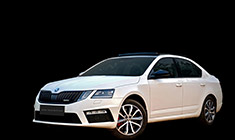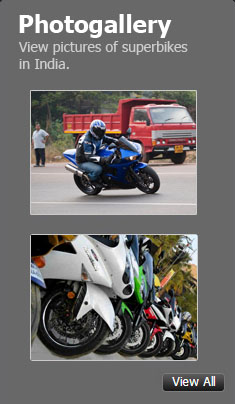News
Skoda Kodiaq Facelift: Observations after a day of driving
An extremely important addition to the 2022 Kodiaq is Skoda’s Dynamic Chassis Control (DCC). This lets you alter between a softer or stiffer suspension setup by simply switching the drive mode.
Driving the Skoda Kodiaq 2.0L Turbo Petrol Automatic
The biggest change in the Kodiaq is under the bonnet. The 2.0L TDI diesel engine has been replaced by a 2.0L TSI petrol engine, which produces 187 BHP @ 4,200 - 6,000 rpm and 320 Nm @ 1,500 - 4,100 rpm. It is mated to a 7-speed DSG transmission with an AWD system. The Kodiaq’s ARAI fuel efficiency rating = 12.78 km/l:

This 2.0-litre turbo petrol engine along with the 7-speed DSG automatic gearbox is the only powertrain on offer in the 2022 Kodiaq. The combination is shared with the Volkswagen Tiguan, Skoda Octavia, Skoda Superb, Audi A4 etc. The performance of this engine is strong with 187 BHP and 320 Nm on tap. With the torque available from low revs, the 2.0 is quite tractable and enjoyable at all speeds. That said, it is disappointing that Skoda hasn't bothered to make its durable, efficient & powerful 2.0 TDI engine BS6-compliant. That puts the Kodiaq at a disadvantage as there are many diesel lovers in the premium segments. Plus, that 2.0 diesel was a workhorse for high-mileage customers in a way that the 2.0 TSI can never be. Petrol has now crossed 100 bucks a litre and there is a significant operating cost difference between 6 - 10 city km/l and 12 - 15 km/l for the heavy runners. Turbo-petrols are also very sensitive to throttle input and if you drive it hard, you'll see the FE drop alarmingly. Important to note that all crossovers & SUVs in this price band (except the Tiguan) offer a diesel.
In the city, the 2.0 motor's healthy bottom end helps you get around effortlessly. Throttle response is good and the Kodiaq moves smoothly. Add to that, the direct injection and turbocharger ensure that the engine isn't lethargic at low RPMs. There's always more than enough power on tap to accelerate or overtake quickly. The minimal turbo lag just makes it that much more responsive. While the DSG gearbox is super smooth 99% of the time, it can get jerky at crawling speeds in bumper-to-bumper traffic (an unfortunate DSG trait). Tip: Use the super convenient auto-hold function in traffic.
Drive with a light foot and the gearbox moves up the ratios pretty quickly. It is eager to reach higher gears and you will see it upshift under 2,000 rpm. Impressively though, you won't feel these shifts as the transition is very smooth. The Kodiaq's steering is light at city speeds and the car doesn't feel as big as its dimensions suggest. The Kodiaq is a breeze to drive & you will enjoy driving it in the city.
Out on the highway is when things go from good to great! This is a fun-to-drive crossover in a way that the big body-on-frame SUVs (Fortuner, Gloster) can never be. You'll find yourself addicted to flooring the throttle whenever there's an empty stretch of road. Outright performance is good and the strong mid-range takes care of all the overtaking you need to do (not as sprightly as the lighter Octavia 2.0 TSI though). The downshifts are quick and the gearbox responds well to throttle inputs, especially in "Sport" mode. The engine revs beautifully to ~6,200 rpm and importantly, sounds lovely and sporty while doing so. While this is enjoyable, we would have liked to see 6,500 - 6,700 rpm to play with as this rpm level is way too low (some diesels rev to 5,500 rpm!). In terms of cruisability, the Kodiaq can run at triple-digit speeds all day long without breaking into a sweat. The engine spins at a relaxed ~1,700 rpm at 100 km/h and ~2,000 rpm at 120 km/h. And touring you must do - this car is built for long-distance road trips. In summary, the 2.0 TSI is a jewel of a motor that will keep you happy at low revs & high, and in the city as well as on the highway.
The Kodiaq uses a 7-speed DSG gearbox, which belongs to the DQ381 family and has a wet clutch setup. The DQ381 has been around for a couple of years internationally and online customer complaints are fewer in number than VW's older DSGs. Still, we have serious reservations regarding the long-term reliability of any VW / Skoda DSG and strongly recommend getting that extended warranty.
Cruising around in D mode, one won't even notice the gears being shifted. They are damn smooth. The kickdown response time is quick and you will never feel that the gearbox is hunting for gears either. It's in the right ratio almost all the time. When you are in the mood to drive the car aggressively, engage 'Sport' mode. This puts the car in 'high alert' mode and its senses are heightened. The DSG holds onto gears longer before upshifting and you'll also notice that the gearbox is eager to downshift at the slightest of throttle inputs. People with a heavy foot will love S mode for sure. However, in the city where the traffic is heavy, S mode can get jerky.
Paddle shifters have been provided and you will enjoy using them with this turbo-petrol. The response time is quick and they are fun to use on a twisty section of road. Tap the left paddle for a downshift and you'll notice the ECU blipping the throttle to match the revs, which is quite satisfying & addictive. There's a good amount of engine braking available too. But again, with such a combination, the paddle shifters would've been a lot more fun if the engine offered 500 - 1,000 more revs to play with.
The Kodiaq's DSG features an "S" mode that changes the gearbox's shift points. The gearbox holds onto gear longer too. One can engage the manual Tiptronic mode by moving the gear lever to the left into the Tiptronic gate, or by clicking on any of the plastic paddles. Tiptronic works in both "D" & "S" modes. The response time in Tiptronic is decent and the DSG holds on to gears. One can use this mode to keep the engine in its powerband, which can be useful for overtaking manoeuvres.
Apart from the gearbox's "S" mode, the Kodiaq has a host of driving modes, which change the parameters of the dynamic chassis control, engine, gearbox, steering, ESP, adaptive lights and air-con. There are a total of six drive modes to choose from – Eco, Comfort, Normal, Sport, Snow and Individual. The Kodiaq gets a dedicated ‘Mode’ button below the gear lever to select the drive mode. The default mode is the "Normal" mode. Each mode changes the engine's characteristics, suspension settings, gearbox shift points, air-con operation, steering weight etc.
- Comfort mode: As the name suggests, everything is in the most comfortable setting in this mode - the suspension, engine map, steering etc. The suspension tune in comfort mode is the most absorbent and I found it just perfect for Mumbai roads. Use this for everyday driving in your city.
- Sport mode: Engage Sport mode and you'll feel the throttle to be sharper. The engine feels more responsive in Sport mode for sure. The suspension firms up noticeably. This is the mode for when you're in the 'mood' for fun, but not for everyday driving or on bad roads where it can get bumpy. For regular city driving, this mode can feel peaky. The steering feels heavier than the other modes & the headlights adjust more dynamically here.
- Eco mode: The climate control doesn't work as hard in Eco mode - it still cools the cabin sufficiently though. Power delivery is lazier, with the throttle response dulled a bit. Overall, because the engine is reasonably powerful, Eco mode is still useable. It doesn't feel too sluggish and there is sufficient grunt on tap to keep you cruising at higher speeds. When it comes to quick overtaking, you will need Normal or Sport modes.
- Individual mode: The driver can choose to adjust the individual parameters such as the damper settings (DCC), steering, air-conditioning etc according to his/her preferences.
- Snow: This should be engaged on icy or snow-covered roads. It provides better accelerator sensitivity in these conditions.
The Kodiaq comes with a convenient 'auto hold' feature which owners will love in the city. While the vehicle is waiting at a signal, the driver can lift his foot off the brake pedal and the vehicle will stay in place. No need to keep the brake pedal continuously pressed.
Skoda has equipped the Kodiaq with an all-wheel-drive system. As is usually the case with such crossovers, in normal conditions, the system sends power to the front wheels only. If road conditions require more traction, it will send the necessary amount of torque to the rear wheels. The system monitors which of the four wheels has the most traction and is able to send torque to those wheels. If slippery roads make a wheel lose traction, the system hits the brake on that wheel and transfers the remaining power to the other wheels. The AWD will help you when touring remote parts of the country and over the likes of slush, muck & sand. It's no offroader like the Fortuner though.
Like in the old Kodiaq Scout, you get an Off-Road button. In this mode, accelerator sensitivity is adjusted for rough terrain and unpaved roads. Engine braking is always available and hill start assist + hill descent control are switched on. Acceleration is restricted while driving downhill and it is not possible to shift to "S" mode.
Noise, Vibration & Harshness (NVH)
As you would expect in a premium SUV like this, refinement levels are overall satisfactory. The engine idles softly and you'd barely notice it while driving around sedately. Rev the 2.0 TSI and a nice, sporty note is audible in the cabin. Wind noise is well controlled even when driving at 120 km/h.
Mileage & Fuel Economy
The Kodiaq 2.0 TSI engine with the DSG automatic has an ARAI rating of 12.78 km/l. We would expect 7 - 9 km/l in the city, depending on traffic density. Do note that turbo-petrols are very sensitive to throttle input and if you drive it hard (which you will), the fuel gauge will drop much faster and you'll see 5 - 6 kmpl. The Kodiaq's fuel tank capacity is 58 litres.

Ride Comfort
An extremely important addition to the 2022 Kodiaq is Skoda’s Dynamic Chassis Control (DCC). In essence, DCC alters the suspension tune by changing the damper settings (aka adaptive dampers). The shock absorbers get an electromagnetic valve that controls the flow of oil within, depending on the driving situation and the selected driving mode. This lets you alter between a softer or stiffer suspension setup by simply switching the drive mode.
The adaptive dampers give the Kodiaq added flexibility when it comes to ride comfort. The two modes - Comfort and Sport - are especially important in India where road surface quality greatly varies. You can have your cake and eat it too. Choose Comfort when you want to cruise, and Sport when you are in the mood for some fun. This DCC is a crucial selling point for the Kodiaq in a sea of unwieldy body-on-frame SUVs whose ride & handling package is a mixed bag. Even the Kodiaq's sibling - the Tiguan - cannot touch the Skoda's ride quality in "Comfort" mode.
Driving in Comfort mode at low speeds and on broken roads, the suspension soaks up all the potholes quite nicely. It's soft & cushy. This is the mode you'll use the most within the city. The suspension works silently throughout, with only the big potholes registering themselves in the cabin with a loud ‘thud’. Sport mode does noticeably firm things up and there is a big difference from Comfort. The difference is so much that on typically imperfect Mumbai city roads, in Comfort mode, we’ll give the suspension’s cushiness a 9 /10, but in Sport mode, it becomes a 6 / 10 (you feel everything in Sport mode). Do keep in mind that this convenience comes at a price. A suspension overhaul including the DCC will cost you more than that of a conventional suspension setup.
Tip = If you want to experience the difference that the DCC makes, switch directly from Comfort <-> Sport, without bringing 'Normal' mode into the picture (as Normal is a balance between the two).
The Kodiaq rides on 18" rims shod with 235/55 profile tyres, which is the same size as the Tiguan. However, they have a recommended pressure of 35 PSI all-round, which is 1 PSI lesser than the VW.
Handling & Dynamics
A look at the electromagnetic valve that controls the oil flow in the shock absorber depending on the selected driving mode:

The overall suspension tune gives the Kodiaq good high-speed manners, especially in Normal & Sport modes (Comfort makes things too soft for aggressive driving). The car feels solid and very planted. Especially with this 2.0 TSI, you could have a lot of fun with the car in a way that you could never do with the 2.0 TDI because its power rating was a relatively low 138 BHP. High-speed stability is excellent and it feels damn composed at triple-digit speeds. The Kodiaq masks silly speeds with ease in Sport & Normal modes.
The Kodiaq is very car-like to drive, unlike the bulky Fortuner & Gloster. You could drive it just like you do a sedan. Reason = its monocoque construction versus the body-on-frame build of the Toyota & MG. The Kodiaq is a sorted handler, although we do remember the Tiguan feeling more agile. On twisty roads, the car won't feel unstable at any point of time. There is some body roll considering the weight & dimensions of the car, but it's nothing unsettling. The overall behaviour is typically German and there are times when you won't realize that you are driving a 7-seater crossover. Make sure to switch to Sport mode when you’re just about to hit the mountain roads. The firmer suspension setting makes a lot of difference in the way the Kodiaq behaves in the corners. The Kodiaq holds its line well without much drama. The MRF Markus tyres provide a fair deal of grip, but are not excellent.
The Kodiaq is loaded with all-round disc brakes & lots of electronic aids. As you would expect, the brakes are top class. The car had no problems stopping in a straight line, even when we slammed on the brake pedal at speed. The pedal feel is progressive which makes stopping this SUV very predictable.
Continue reading the discussion on the Skoda Kodiaq Facelift on our forum.



















